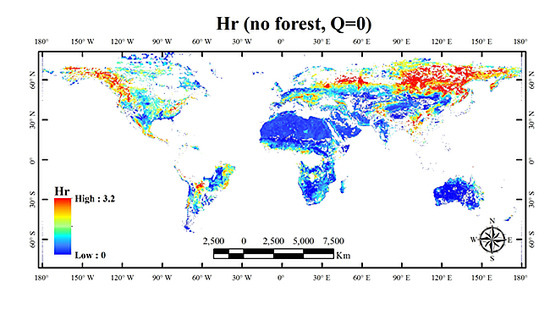Global-Scale Evaluation of Roughness Effects on C-Band AMSR-E Observations
Abstract
:1. Introduction
2. Data
2.1. AMSR-E
2.2. SMOS
2.3. MODIS NDVI
2.4. The SCAN Network
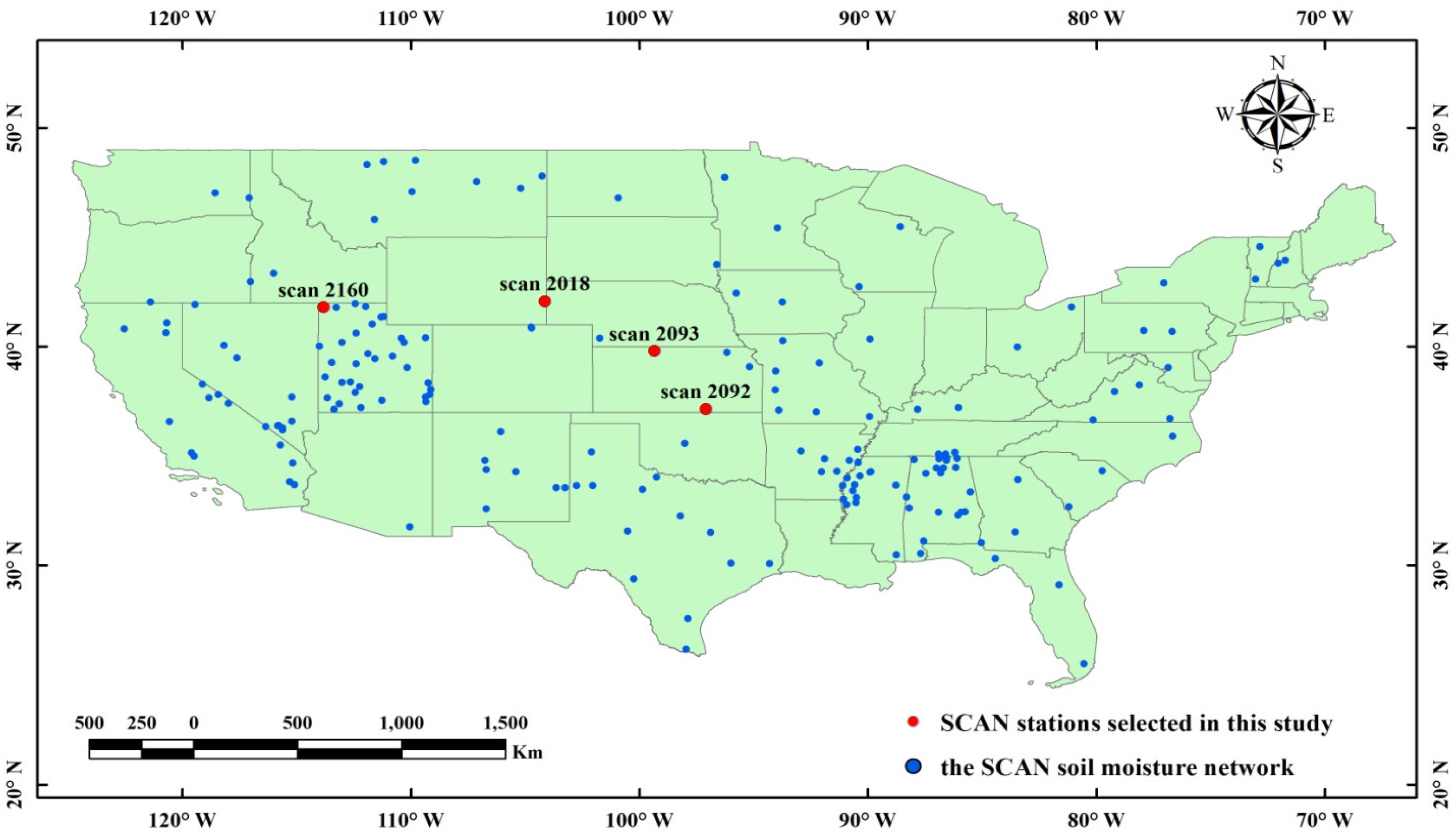
| Node | Station Name | Site | Fractions | Cover Type | Texture | State | ||||
|---|---|---|---|---|---|---|---|---|---|---|
| FNO | FFO | FWO | Other | Sand (%) | Clay (%) | |||||
| 172276 | Grouse Creek | SCAN 2160 | 100 | 0 | 0 | 0 | Grassland (mountain) | -- | -- | Utah |
| 186675 | Torrington | SCAN 2018 | 100 | 0 | 0 | 0 | Grassland | 80.3 | 5.5 | Wyoming |
| 203609 | Phillipsburg | SCAN 2093 | 98 | 0 | 0 | 2 | Crops | 5.8 | 22.4 | Kansas |
| 218480 | Abrams | SCAN 2092 | 97 | 1 | 0 | 2 | Crops | 72.4 | 7.5 | Kansas |
2.5. Ancillary Products
2.6. Remote Sensing Data Pre-Processing
3. Method
- “Bare or sparsely vegetated surfaces”, corresponding here to the case when the effects of the vegetation layer, could be considered negligible over a sufficient period of time (this case was arbitrarily defined here as when 15% of the NDVI values were lower than 0.07 in the whole NDVI time series [64]).
- 2.
- “Vegetated surfaces” corresponding here to the case when the effects of the vegetation layer are significant over most of the dates of the considered dataset (case defined as: more than 85% of the NDVI values exceed the threshold value of 0.07).
4. Results and Discussion
4.1. Results Obtained Over the Selected SCAN Sites
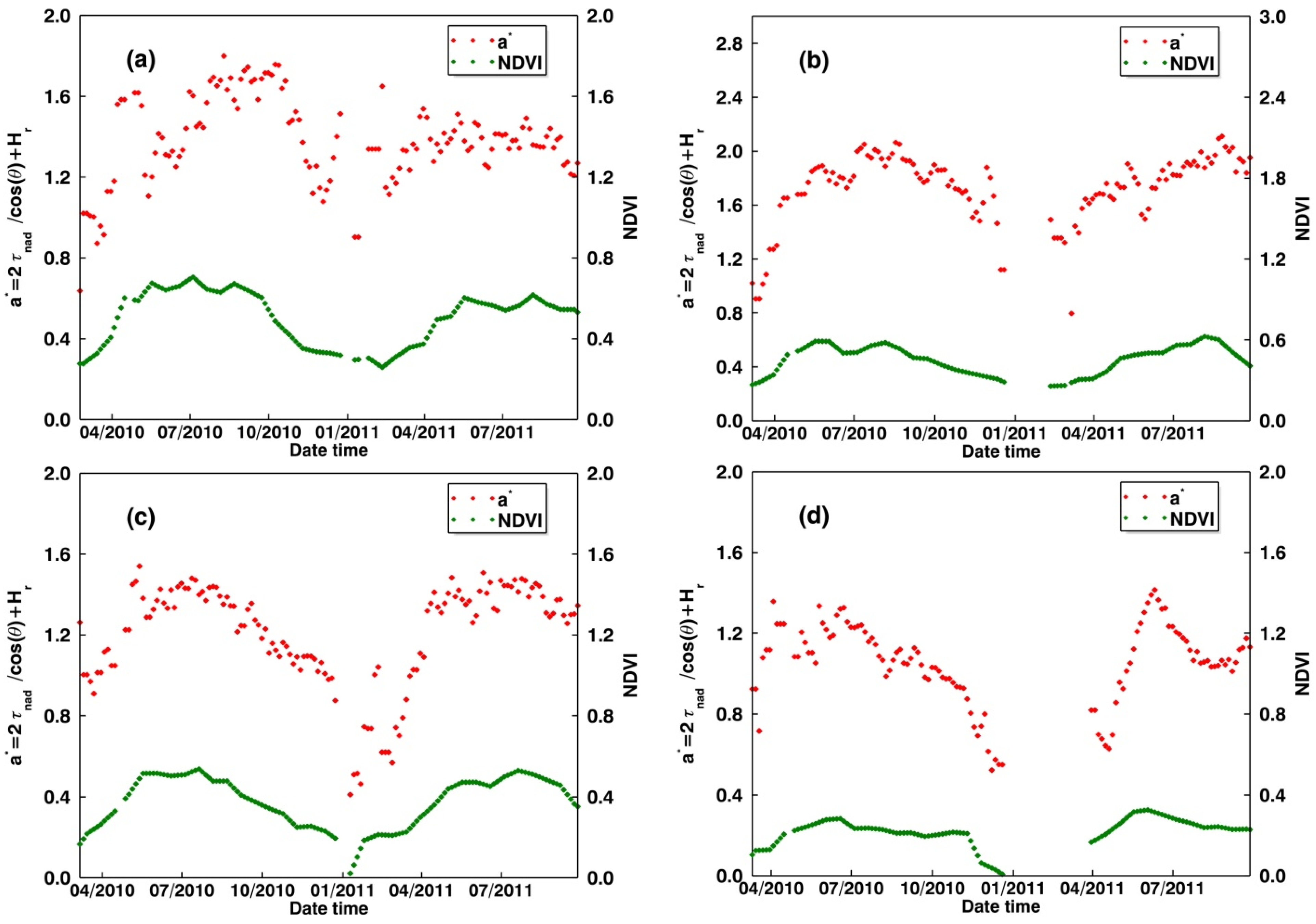
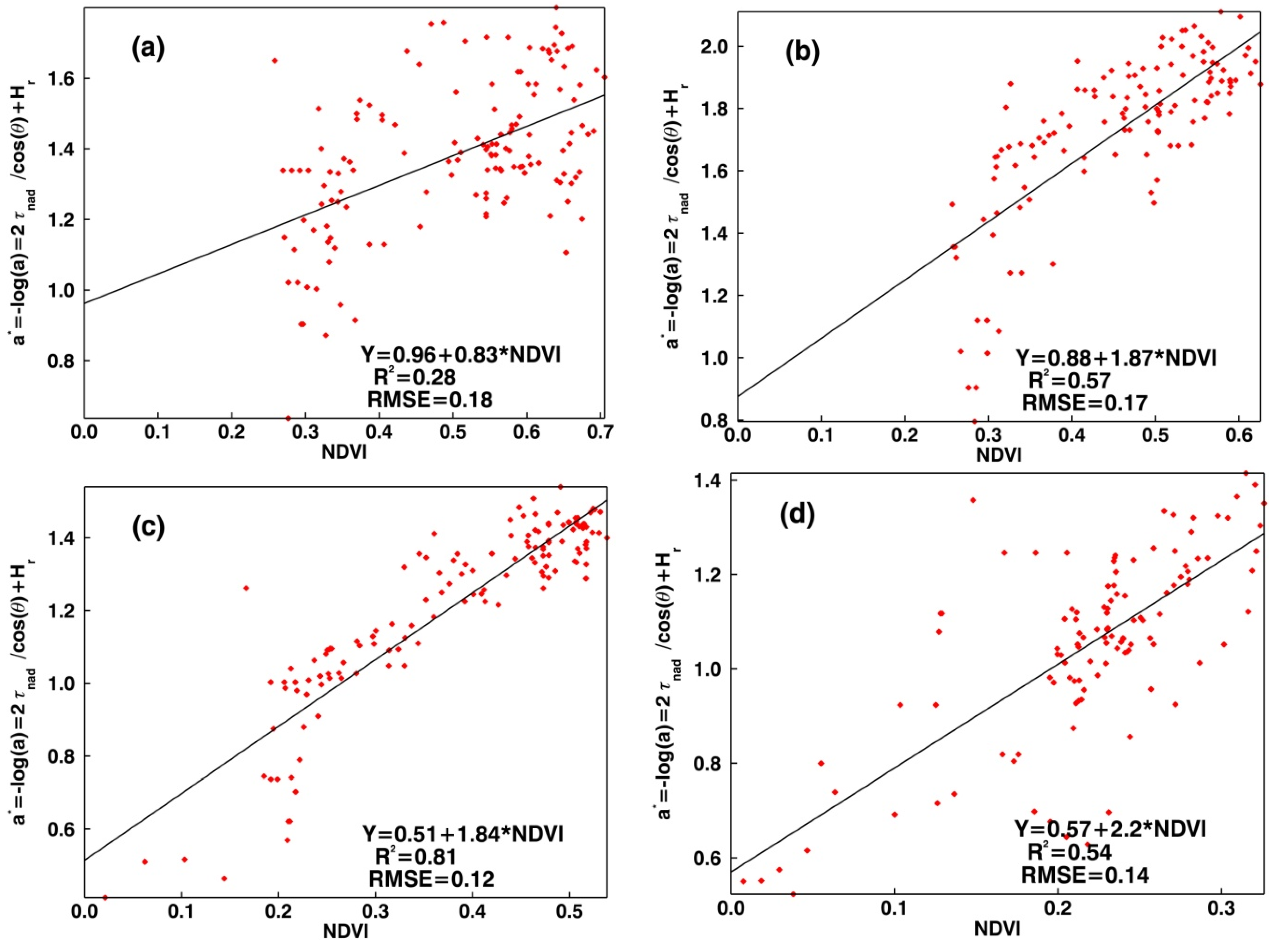
4.2. Global Map of the Hr Values
| Classification | Q = 0 | ||
|---|---|---|---|
| Mean Hr | Mean R2 | N | |
| broadleaf evergreen forest | 1.06 | 0.41 | 2098 |
| broadleaf deciduous forest & woodland | 1.54 | 0.47 | 2526 |
| mixed coniferous & broadleaf deciduous forest & woodland | 1.55 | 0.47 | 2403 |
| coniferous forest & woodland | 1.36 | 0.44 | 4688 |
| high latitude Deciduous forest & woodland | 1.92 | 0.44 | 3674 |
| wooded & grassland | 0.61 | 0.52 | 30,384 |
| shrubs & bare ground | 0.38 | 0.44 | 4827 |
| Tundra | 1.14 | 0.45 | 8362 |
| Cultivation | 0.74 | 0.47 | 22,099 |
| Desert | 0.26 | -- | 25,128 |
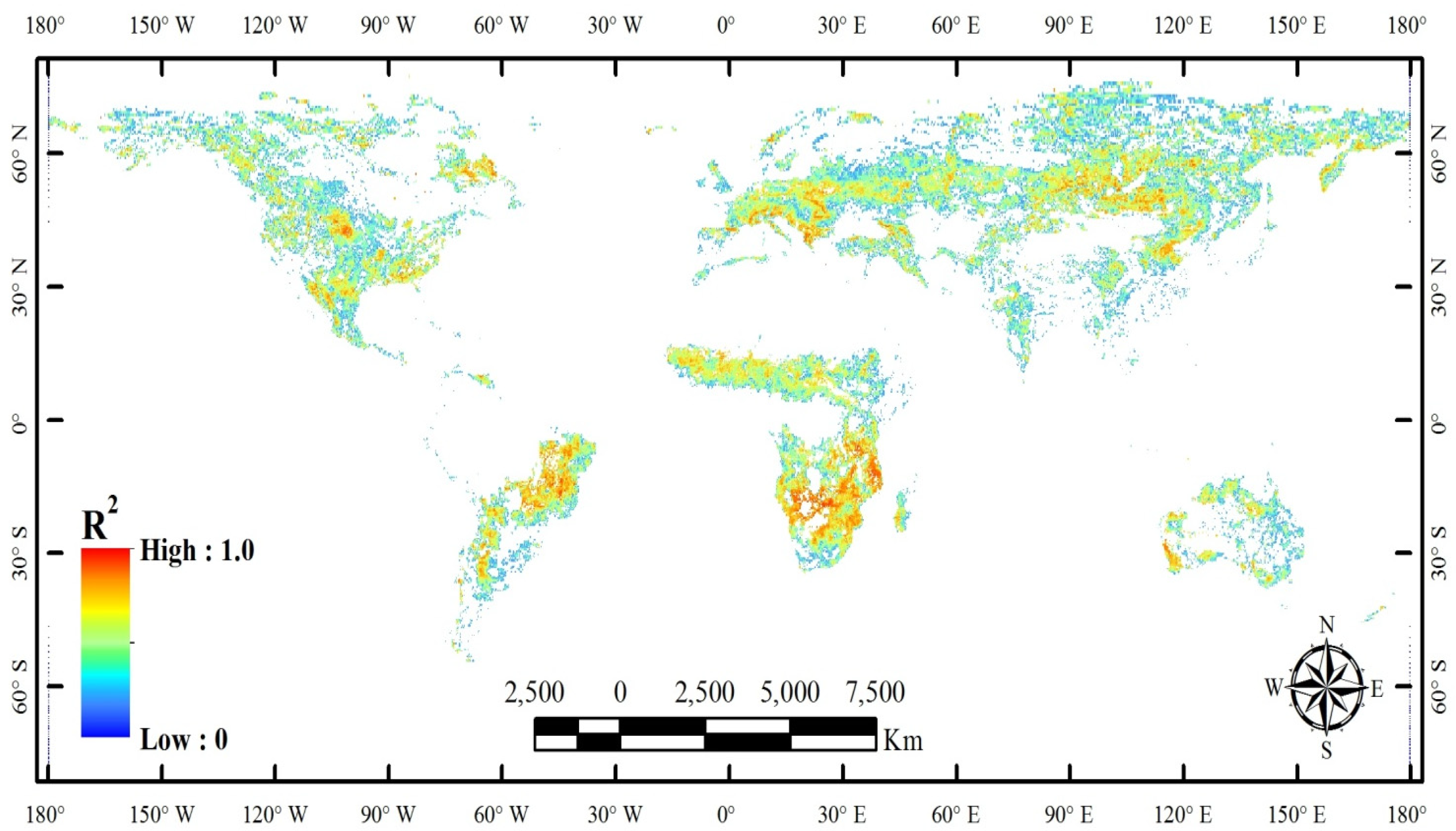
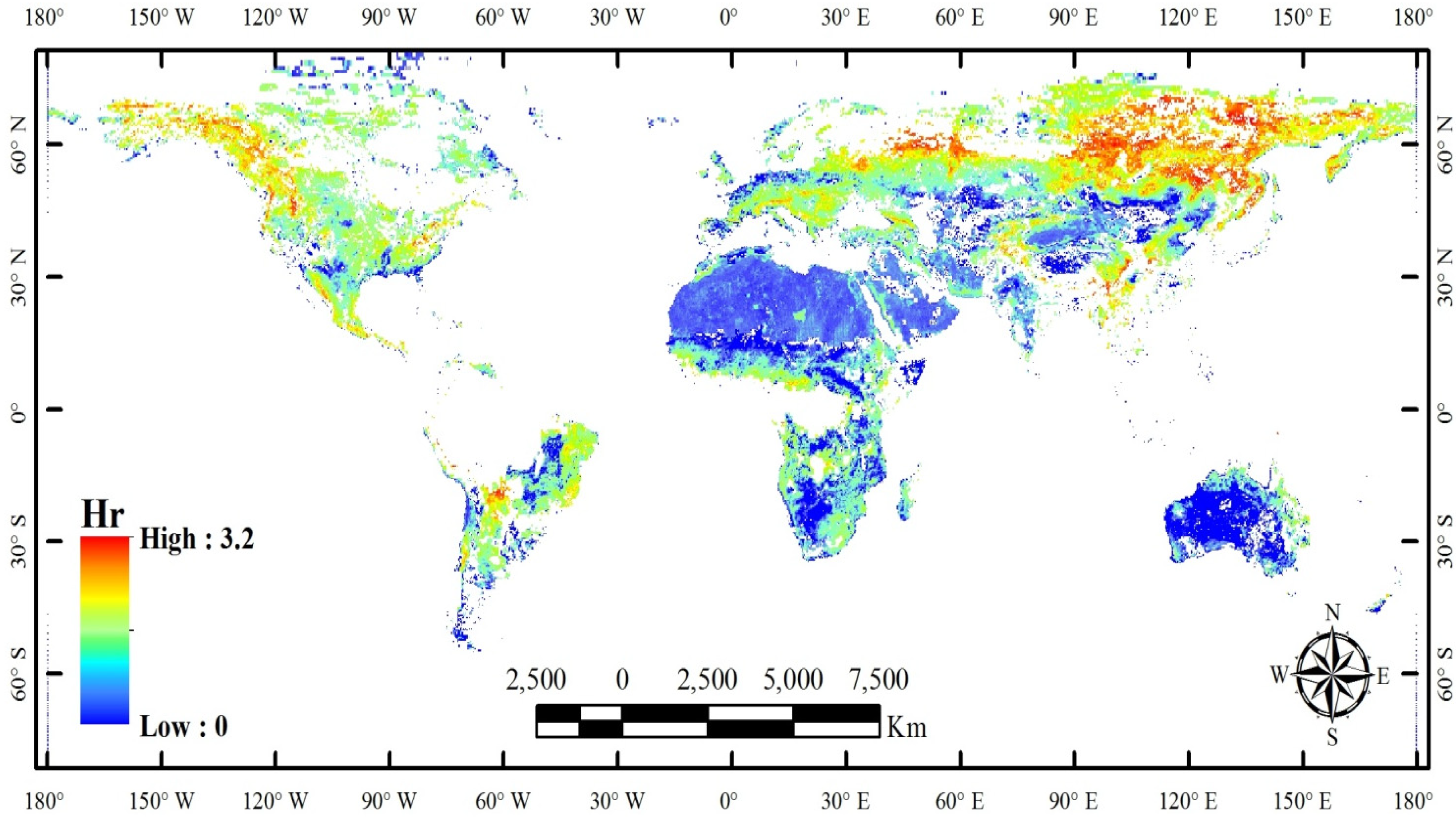
4.3. Maps of Hr Over the USA
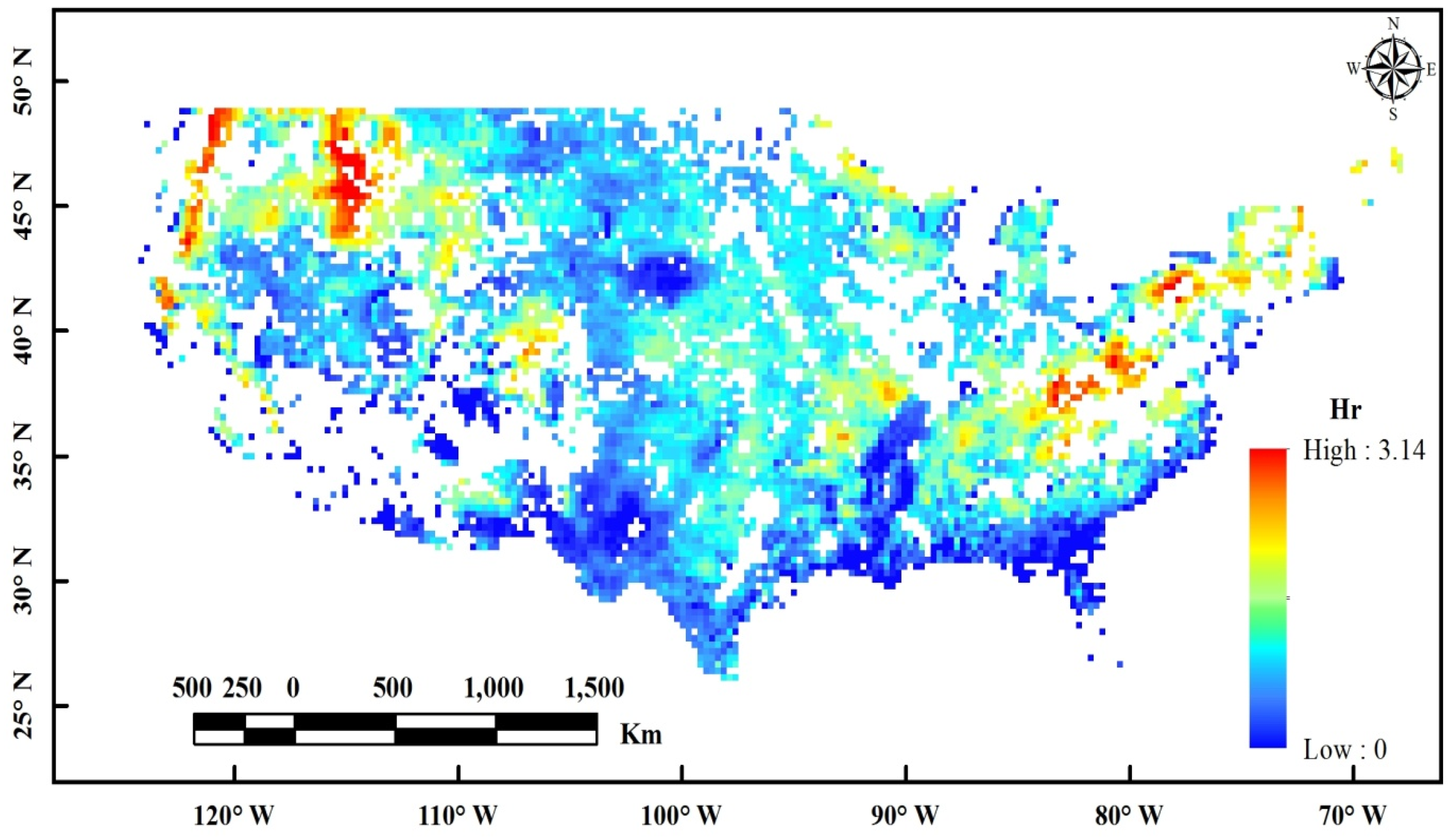


| DEM (m) | Classification | Count | Mean Hr |
|---|---|---|---|
| <200 | Plain | 1080 | 0.60 |
| 200–500 | Plateau | 2420 | 0.95 |
| 500–1000 | Hill | 1501 | 0.78 |
| >1000 | Mountain | 2730 | 0.82 |
| Slope(°) | Classification | Count | Mean Hr |
|---|---|---|---|
| 0–2 | nearly level | 8005 | 0.73 |
| 2–10 | undulating | 526 | 1.23 |
| 10–15 | gently rolling | 135 | 1.42 |
| 15–20 | moderately rolling | 29 | 1.39 |
| 20–25 | strongly rolling | 8 | 2.33 |
4.4. Sensitivity Analysis
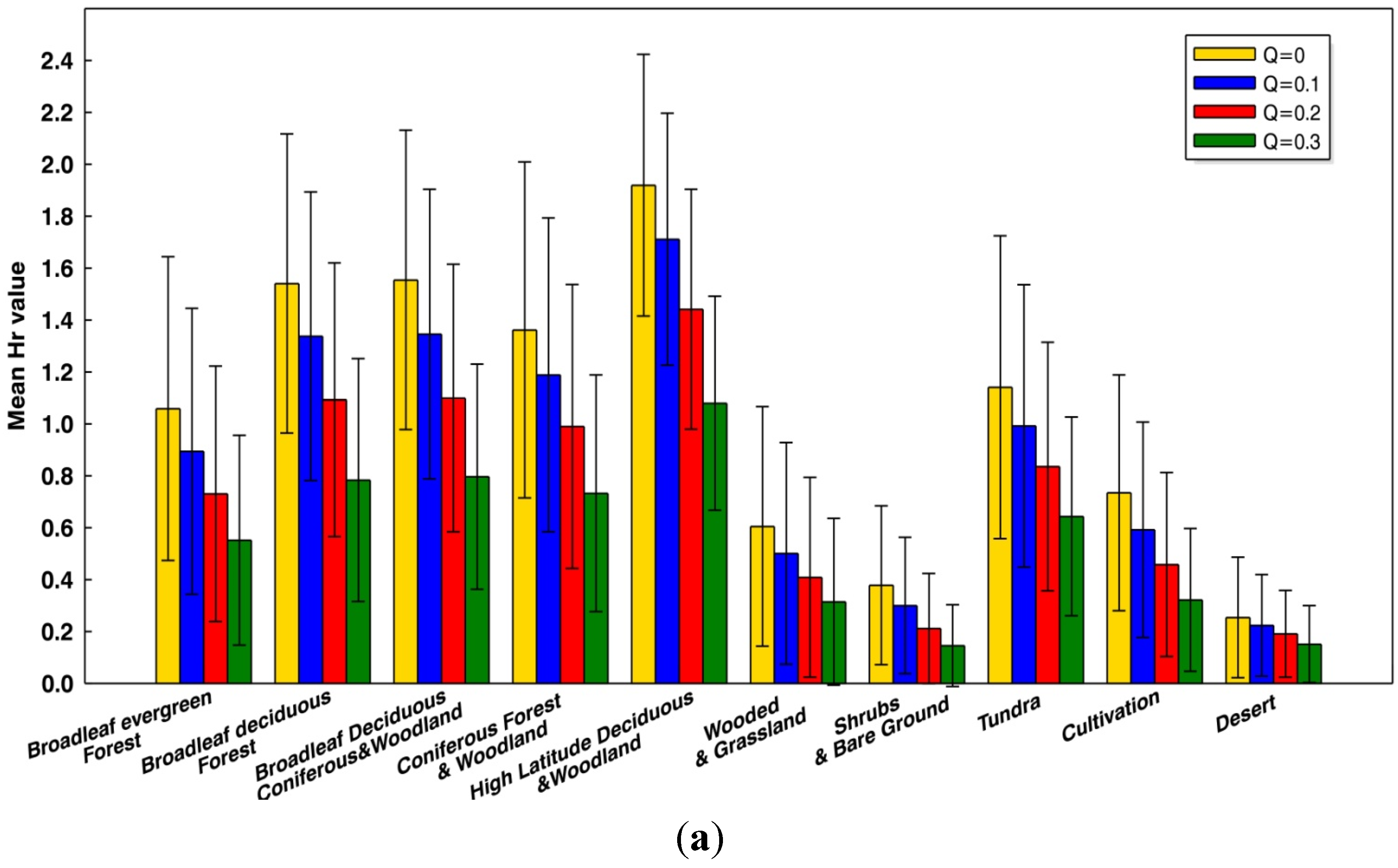
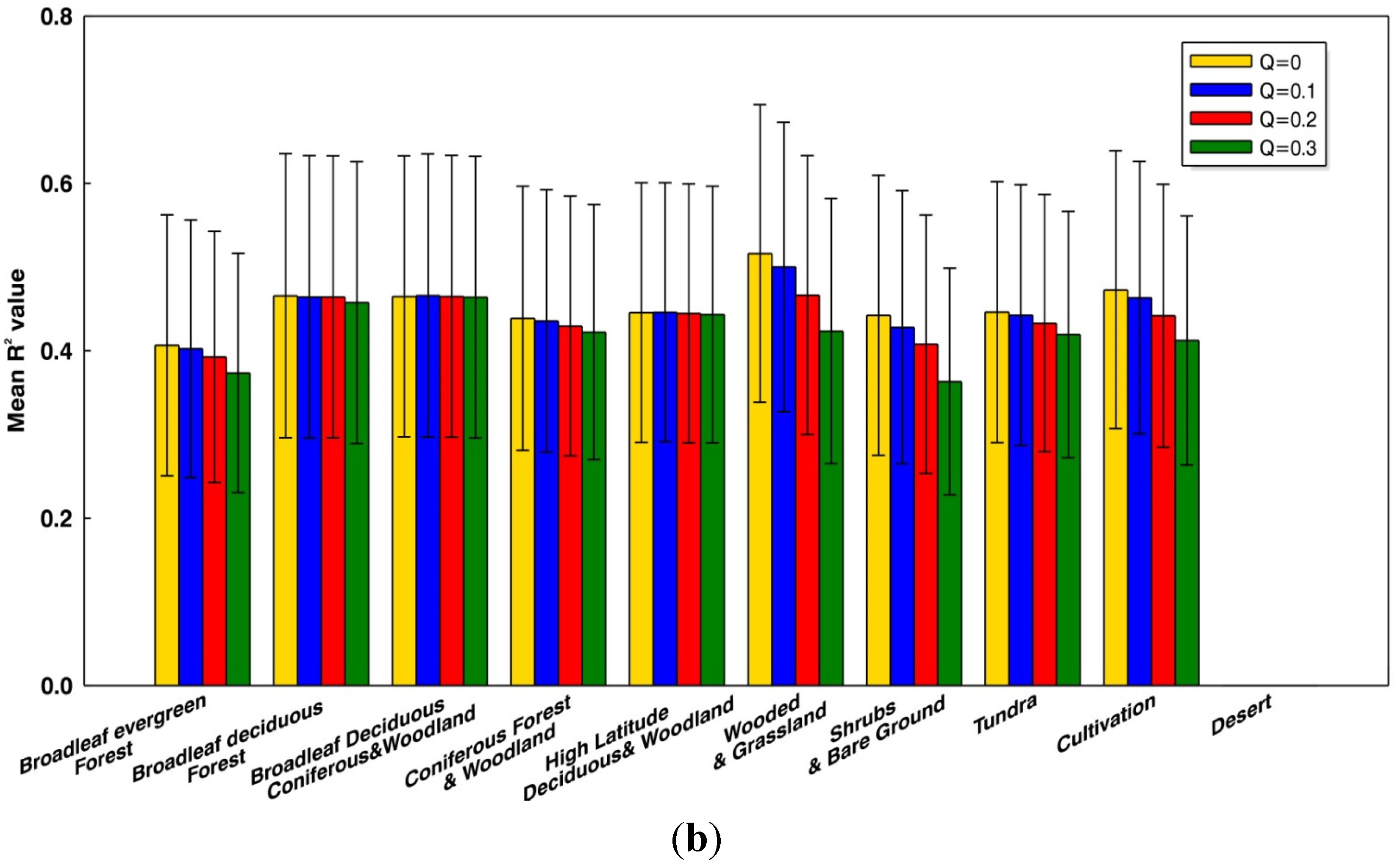
| NDVI Thresholds | Vegetation Threshold | Bare or Sparsely Vegetated Surfaces | Vegetated Surfaces |
|---|---|---|---|
| 0.05 | 85% | 23.98% | 76.12% |
| 0.07 | 80% | 24.03% | 75.97% |
| 85% | 24.03% | 75.97% | |
| 90% | 24.03% | 75.97% | |
| 0.1 | 85% | 24.58% | 75.42% |
| Classification | R2 > 0.3 | ||
|---|---|---|---|
| Mean Hr | Mean R2 | N | |
| Broadleaf evergreen forest | 0.95 | 0.48 | 1451 |
| Broadleaf deciduous forest & woodland | 1.48 | 0.52 | 1998 |
| Mixed coniferous & broadleaf deciduous forest & woodland | 1.57 | 0.52 | 1888 |
| Coniferous forest & woodland | 1.33 | 0.49 | 3548 |
| High latitude deciduous forest & woodland | 1.89 | 0.50 | 2888 |
| Wooded & grassland | 0.57 | 0.56 | 26,043 |
| Shrubs & bare ground | 0.37 | 0.56 | 3641 |
| Tundra | 1.10 | 0.50 | 7950 |
| Cultivation | 0.72 | 0.52 | 20,904 |
| Desert | 0.25 | -- | 24,386 |
5. Conclusions
Acknowledgments
Author Contributions
Conflicts of Interest
References
- Jackson, T.J., III. Measuring surface soil moisture using passive microwave remote sensing. Hydrol. Process. 1993, 7, 139–152. [Google Scholar]
- Drusch, M. Initializing numerical weather prediction models with satellite-derived surface soil moisture: Data assimilation experiments with ECMWF’s integrated forecast system and the TMI soil moisture data set. J. Geophys. Res.: Atmos. 2007, 112, D03102. [Google Scholar] [CrossRef]
- Douville, H.; Chauvin, F. Relevance of soil moisture for seasonal climate predictions: A preliminary study. Clim. Dyn. 2000, 16, 719–736. [Google Scholar] [CrossRef]
- Njoku, E.G.; Jackson, T.J.; Lakshmi, V.; Chan, T.K.; Nghiem, S.V. Soil moisture retrieval from AMSR-E. IEEE Trans. Geosci. Remote Sens. 2003, 41, 215–229. [Google Scholar] [CrossRef]
- Wigneron, J.-P.; Schmugge, T.; Chanzy, A.; Calvet, J.-C.; Kerr, Y. Use of passive microwave remote sensing to monitor soil moisture. Agronomie 1998, 18, 27–43. [Google Scholar] [CrossRef]
- Jackson, T.J.; Gasiewski, A.J.; Oldak, A.; Klein, M.; Njoku, E.G.; Yevgrafov, A.; Christiani, S.; Bindlish, R. Soil moisture retrieval using the C-band polarimetric scanning radiometer during the Southern Great Plains 1999 Experiment. IEEE Trans. Geosci. Remote Sens. 2002, 40, 2151–2161. [Google Scholar] [CrossRef]
- Njoku, E.G.; Chan, S.K. Vegetation and surface roughness effects on AMSR-E land observations. Remote Sens. Environ. 2006, 100, 190–199. [Google Scholar] [CrossRef]
- Njoku, E.G.; Entekhabi, D. Passive microwave remote sensing of soil moisture. J. Hydrol. 1996, 184, 101–129. [Google Scholar] [CrossRef]
- Wigneron, J.P.; Calvet, J.C.; Pellarin, T.; Van de Griend, A.A.; Berger, M.; Ferrazzoli, P. Retrieving near-surface soil moisture from microwave radiometric observations: Current status and future plans. Remote Sens. Environ. 2003, 85, 489–506. [Google Scholar] [CrossRef]
- Al Bitar, A.; Leroux, D.; Kerr, Y.H.; Merlin, O.; Richaume, P.; Sahoo, A.; Wood, E.F. Evaluation of SMOS soil moisture products over continental U.S. using the SCAN/SNOTEL network. IEEE Trans. Geosci. Remote Sens. 2012, 50, 1572–1586. [Google Scholar]
- Wigneron, J.P.; Calvet, J.C.; Kerr, Y.; Chanzy, A.; Lopes, A. Microwave emission of vegetation: Sensitivity to leaf characteristics. IEEE Trans. Geosci. Remote Sens. 1993, 31, 716–726. [Google Scholar] [CrossRef]
- Wigneron, J.-P.; Chanzy, A.; Calvet, J.-C.; Bruguier, N. A simple algorithm to retrieve soil moisture and vegetation biomass using passive microwave measurements over crop fields. Remote Sens. Environ. 1995, 51, 331–341. [Google Scholar] [CrossRef]
- Bindlish, R.; Jackson, T.J.; Gasiewski, A.J.; Klein, M.; Njoku, E.G. Soil moisture mapping and AMSR-E validation using the PSR in SMEX02. Remote Sens. Environ. 2006, 103, 127–139. [Google Scholar] [CrossRef]
- Wigneron, J.P.; Parde, M.; Waldteufel, P.; Chanzy, A.; Kerr, Y.; Schmidl, S.; Skou, N. Characterizing the dependence of vegetation model parameters on crop structure, incidence angle, and polarization at L-band. IEEE Trans. Geosci. Remote Sens. 2004, 42, 416–425. [Google Scholar] [CrossRef]
- Saleh, K.; Wigneron, J.P.; Waldteufel, P.; de Rosnay, P.; Schwank, M.; Calvet, J.C.; Kerr, Y.H. Estimates of surface soil moisture under grass covers using L-band radiometry. Remote Sens. Environ. 2007, 109, 42–53. [Google Scholar] [CrossRef]
- Al-Yaari, A.; Wigneron, J.P.; Ducharne, A.; Kerr, Y.; de Rosnay, P.; de Jeu, R.; Govind, A.; Al Bitar, A.; Albergel, C.; Muñoz-Sabater, J.; et al. Global-scale evaluation of two satellite-based passive microwave soil moisture datasets (SMOS and AMSR-E) with respect to land data assimilation system estimates. Remote Sens. Environ. 2014, 149, 181–195. [Google Scholar] [CrossRef] [Green Version]
- Jacquette, E.; Al Bitar, A.; Mialon, A.; Kerr, Y.; Quesney, A.; Cabot, F.; Richaume, P. SMOS CATDS level 3 global products over land. Proc. SPIE 2010, 7824, 375–380. [Google Scholar]
- Wigneron, J.P.; Laguerre, L.; Kerr, Y.H. A simple parameterization of the L-band microwave emission from rough agricultural soils. IEEE Trans. Geosci. Remote Sens. 2001, 39, 1697–1707. [Google Scholar] [CrossRef]
- Choudhury, B.J.; Schmugge, T.J.; Chang, A.; Newton, R.W. Effect of surface roughness on the microwave emission from soils. J. Geophys. Res.: Ocean. 1979, 84, 5699–5706. [Google Scholar] [CrossRef]
- Shi, J.C.; Chen, K.S.; Qin, L.; Jackson, T.J.; O’Neill, P.E.; Leung, T. A parameterized surface reflectivity model and estimation of bare-surface soil moisture with L-band radiometer. IEEE Trans. Geosci. Remote Sens. 2002, 40, 2674–2686. [Google Scholar] [CrossRef]
- Mialon, A.; Wigneron, J.P.; de Rosnay, P.; Escorihuela, M.J.; Kerr, Y.H. Evaluating the L-MEB model from long-term microwave measurements over a rough field, SMOSREX 2006. IEEE Trans. Geosci. Remote Sens. 2012, 50, 1458–1467. [Google Scholar] [CrossRef] [Green Version]
- Mo, T.; Choudhury, B.J.; Schmugge, T.J.; Wang, J.R.; Jackson, T.J. A model for microwave emission from vegetation-covered fields. J. Geophys. Res.: Ocean. 1982, 87, 11229–11237. [Google Scholar] [CrossRef]
- Lawrence, H.; Wigneron, J.P.; Demontoux, F.; Mialon, A.; Kerr, Y.H. Evaluating the semiempirical H-Q model used to calculate the L-band emissivity of a rough bare soil. IEEE Trans. Geosci. Remote Sens. 2013, 51, 4075–4084. [Google Scholar] [CrossRef]
- Fernandez-Moran, R.; Wigneron, J.P.; Lopez-Baeza, E.; Salgado-Hernanz, P.M.; Mialon, A.; Miernecki, M.; Alyaari, A.; Parrens, M.; Schwank, M.; Wang, S.; et al. Evaluating the impact of roughness in soil moisture and optical thickness retrievals over the VAS area. In Proceedings of 2014 IEEE International Geoscience and Remote Sensing Symposium (IGARSS 2014), 13–18 July 2014; pp. 1947–1950.
- Wang, J.R.; Choudhury, B.J. Remote sensing of soil moisture content, over bare field at 1.4 GHz frequency. J. Geophys. Res.: Ocean. 1981, 86, 5277–5282. [Google Scholar] [CrossRef]
- Wigneron, J.P.; Kerr, Y.; Waldteufel, P.; Saleh, K.; Escorihuela, M.J.; Richaume, P.; Ferrazzoli, P.; de Rosnay, P.; Gurney, R.; Calvet, J.C.; et al. L-band microwave emission of the biosphere (L-MEB) model: Description and calibration against experimental data sets over crop fields. Remote Sen. Environ. 2007, 107, 639–655. [Google Scholar] [CrossRef]
- Montpetit, B.; Royer, A.; Wigneron, J.P.; Chanzy, A.; Mialon, A. Evaluation of multi-frequency bare soil microwave reflectivity models. Remote Sens. Environ. 2015, 162, 186–195. [Google Scholar] [CrossRef]
- Owe, M.; de Jeu, R.; Holmes, T. Multisensor historical climatology of satellite-derived global land surface moisture. J. Geophys. Res.: Earth Surf. 2008, 113, F01002. [Google Scholar] [CrossRef]
- Jackson, T.J.; Cosh, M.H.; Bindlish, R.; Starks, P.J.; Bosch, D.D.; Seyfried, M.; Goodrich, D.C.; Moran, M.S.; Jinyang, D. Validation of advanced microwave scanning radiometer soil moisture products. IEEE Trans. Geosci. Remote Sens. 2010, 48, 4256–4272. [Google Scholar] [CrossRef]
- Kerr, Y.H.; Njoku, E.G. A semiempirical model for interpreting microwave emission from semiarid land surfaces as seen from space. IEEE Trans. Geosci. Remote Sens. 1990, 28, 384–393. [Google Scholar] [CrossRef]
- Kerr, Y.H.; Waldteufel, P.; Wigneron, J.P.; Martinuzzi, J.; Font, J.; Berger, M. Soil moisture retrieval from space: The soil moisture and Ocean Salinity (SMOS) mission. IEEE Trans. Geosci. Remote Sens. 2001, 39, 1729–1735. [Google Scholar] [CrossRef]
- Kerr, Y.H.; Waldteufel, P.; Wigneron, J.P.; Delwart, S.; Cabot, F.; Boutin, J.; Escorihuela, M.J.; Font, J.; Reul, N.; Gruhier, C.; et al. The SMOS mission: New tool for monitoring key elements of the global water cycle. Proc. IEEE 2010, 98, 666–687. [Google Scholar] [CrossRef] [Green Version]
- Kerr, Y.H.; Waldteufel, P.; Richaume, P.; Wigneron, J.P.; Ferrazzoli, P.; Mahmoodi, A.; Al Bitar, A.; Cabot, F.; Gruhier, C.; Juglea, S.E.; et al. The SMOS soil moisture retrieval algorithm. IEEE Trans. Geosci. Remote Sens. 2012, 50, 1384–1403. [Google Scholar] [CrossRef]
- Al-Yaari, A.; Wigneron, J.P.; Ducharne, A.; Kerr, Y.H.; Wagner, W.; De Lannoy, G.; Reichle, R.; Al Bitar, A.; Dorigo, W.; Richaume, P.; et al. Global-scale comparison of passive (SMOS) and active (ASCAT) satellite based microwave soil moisture retrievals with soil moisture simulations (MERRA-Land). Remote Sens. Environ. 2014, 152, 614–626. [Google Scholar] [CrossRef] [Green Version]
- Berthon, L.; Mialon, A.; Cabot, F.; Bitar, A.A.; Richaume, P.; Kerr, Y.; Leroux, D.; Bircher, S.; Lawrence, H.; Quesney, A.; et al. CATDS Level 3 DATA Product Description-Soil Moisture and Brightness Temperature Part; CESBIO: Toulouse, France, 2012. [Google Scholar]
- Kerr, Y.; Waldteufel, P.; Richaume, P.; Ferrazzoli, P.; Wigneron, J.P. Algorithm Theoretical Basis Document (ATBD) for the SMOS Level 2 Soil Moisture Processor; CESBIO: Toulouse, France, 2011. [Google Scholar]
- Xinxin, L.; Lixin, Z.; Weihermuller, L.; Lingmei, J.; Vereecken, H. Measurement and simulation of topographic effects on passive microwave remote sensing over mountain areas: A case study from the Tibetan Plateau. IEEE Trans. Gesosci. Remote Sens. 2014, 52, 1489–1501. [Google Scholar] [CrossRef]
- Huete, A.; Justice, C.; Wim, V.L. MODIS Vegetation Index (MOD13). Algorithm Theoretical Basis Document. Available online: http://vip.arizona.edu/documents/MODIS/MODIS_VI_ATBD.pdf (accessed on 1 February 2006).
- Lawrence, H.; Wigneron, J.-P.; Richaume, P.; Novello, N.; Grant, J.; Mialon, A.; Al Bitar, A.; Merlin, O.; Guyon, D.; Leroux, D.; et al. Comparison between SMOS vegetation optical depth products and MODIS vegetation indices over crop zones of the USA. Remote Sens. Environ. 2014, 140, 396–406. [Google Scholar] [CrossRef]
- Schaefer, G.L.; Cosh, M.H.; Jackson, T.J. The USDA natural resources conservation service soil climate analysis network (SCAN). J. Atmos. Ocean. Technol. 2007, 24, 2073–2077. [Google Scholar] [CrossRef]
- Grant, J.P.; Wigneron, J.P.; van de Griend, A.A.; Kruszewski, A.; Søbjærg, S.S.; Skou, N. A field experiment on microwave forest radiometry: L-band signal behaviour for varying conditions of surface wetness. Remote Sens. Environ. 2007, 109, 10–19. [Google Scholar] [CrossRef]
- Parrens, M.; Wigneron, J.P.; Richaume, P.; Kerr, Y.; Wang, S.; Alyaari, A.; Fernandez-Moran, R.; Mialon, A.; Escorihuela, M.J.; Grant, J.P. Global maps of roughness parameters from L-band SMOS observations. In Proceedings of 2014 IEEE International Geoscience and Remote Sensing Symposium (IGARSS 2014), 13–18 July 2014; pp. 4675–4678.
- Dirmeyer, P.A.; Gao, X.; Zhao, M.; Guo, Z.; Oki, T.; Hanasaki, N. GSWP-2: Multimodel analysis and implications for our perception of the land surface. Bull. Am. Meteorol. Soc. USA 2006, 87, 1381–1397. [Google Scholar] [CrossRef]
- Fao, F. UNESCO Soil Map of the World; World Resources Report; ISRIC: Wageningen, The Netherlands, 1988; p. 138. [Google Scholar]
- Verdin, K.L.; Jenson, S. Development of continental scale DEMs and extraction of hydrographic features. In Proceedings of the Third International Conference/Workshop on Integrating GIS and Environmental Modeling, Santa Fe, NM, USA, 21–25 January 1996.
- Njoku, E.G.; Ashcroft, P.; Chan, T.K.; Li, L. Global survey and statistics of radio-frequency interference in AMSR-E land observations. IEEE Trans. Geosci. Remote Sens. 2005, 43, 938–947. [Google Scholar] [CrossRef]
- Oliva, R.; Daganzo, E.; Kerr, Y.H.; Mecklenburg, S.; Nieto, S.; Richaume, P.; Gruhier, C. SMOS Radio frequency interference scenario: Status and actions taken to improve the RFI environment in the 1400-1427-MHz passive band. IEEE Trans. Geosci. Remote Sens. 2012, 50, 1427–1439. [Google Scholar] [CrossRef] [Green Version]
- Li, L.; Njoku, E.; Im, E.; Chang, P.; St.Germain, K. A preliminary survey of radio-frequency interference over the U.S. in Aqua AMSR-E data. IEEE Trans. Geosci. Remote Sens. 2004, 42, 380–390. [Google Scholar] [CrossRef]
- Skou, N.; Misra, S.; Balling, J.E.; Kristensen, S.S.; Sobjaerg, S.S. L-Band RFI as experienced during airborne campaigns in preparation for SMOS. IEEE Trans. Geosci. Remote Sens. 2010, 48, 1398–1407. [Google Scholar] [CrossRef]
- Draper, C.; Mahfouf, J.F.; Calvet, J.C.; Martin, E.; Wagner, W. Assimilation of ASCAT near-surface soil moisture into the SIM hydrological model over France. Hydrol. Earth Syst. Sci. 2011, 15, 3829–3841. [Google Scholar] [CrossRef] [Green Version]
- Mladenova, I.E.; Jackson, T.J.; Njoku, E.; Bindlish, R.; Chan, S.; Cosh, M.H.; Holmes, T.R.H.; de Jeu, R.A.M.; Jones, L.; Kimball, J.; et al. Remote monitoring of soil moisture using passive microwave-based techniques—Theoretical basis and overview of selected algorithms for AMSR-E. Remote Sens. Environ. 2014, 144, 197–213. [Google Scholar] [CrossRef]
- Van de Griend, A.A.; Owe, M. Microwave vegetation optical depth and inverse modelling of soil emissivity using Nimbus/SMMR satellite observations. Meteorl. Atmos. Phys. 1994, 54, 225–239. [Google Scholar]
- Kurum, M. Quantifying scattering albedo in microwave emission of vegetated terrain. Remote Sens. Environ. 2013, 129, 66–74. [Google Scholar] [CrossRef]
- Jackson, T.J.; ASCE, A.M. Profile soil moisture from surface measurements. J. Irrig. Drain. Div. 1980, 106, 81–92. [Google Scholar]
- Wang, S.; Wigneron, J.P.; Parrens, M.; Al-Yaari, A.; Fernandez-Moran, R.; Jiang, L.M.; Zeng, J.Y.; Kerr, Y. Evaluating roughness effects on C-band AMSR-E observations. In Proceedings of 2014 IEEE International Geoscience and Remote Sensing Symposium (IGARSS 2014), 13–18 July 2014; pp. 3311–3314.
- Martens, B.; Lievens, H.; Walker, J.; Panciera, R.; Tanase, M.; Monerris, A.; Gao, Y.; Wu, X.L.; Verhoest, N. An alternative roughness parameterization for soil moisture retrievals from passive microwave observations. In Proceedings of the 2013 ESA Living Planet Symposium, Edinburgh, UK, 9–13 September 2013.
- Wang, J.R.; O’Neill, P.E.; Jackson, T.J.; Engman, E.T. Multifrequency measurements of the effects of soil moisture, soil texture, and surface roughness. IEEE Trans. Geosci. Remote Sens. 1983, GE-21, 44–51. [Google Scholar] [CrossRef]
- Owe, M.; de Jeu, R.; Walker, J. A methodology for surface soil moisture and vegetation optical depth retrieval using the microwave polarization difference index. IEEE Trans. Geosci. Remote Sens. 2001, 39, 1643–1654. [Google Scholar] [CrossRef]
- Schmugge, T.; Jackson, T.J.; Kustas, W.P.; Wang, J.R. Passive microwave remote sensing of soil moisture: Results from HAPEX, FIFE and MONSOON 90. ISPRS J. Photogramm. Remote Sens. 1992, 47, 127–143. [Google Scholar] [CrossRef]
- Semi-empirical regressions at L-band applied to surface soil moisture retrievals over grass. Remote Sens. Environ. 2006, 101, 415–426. [CrossRef]
- Zeng, J.Y.; Li, Z.; Chen, Q.; Bi, H.Y. A simplified physically-based algorithm for surface soil moisture retrieval using AMSR-E data. Front. Earth Sci. 2014, 8, 427–438. [Google Scholar] [CrossRef]
- Jones, M.O.; Jones, L.A.; Kimball, J.S.; McDonald, K.C. Satellite passive microwave remote sensing for monitoring global land surface phenology. Remote Sens. Environ. 2011, 115, 1102–1114. [Google Scholar] [CrossRef]
- Liu, Y.Y.; de Jeu, R.A.M.; McCabe, M.F.; Evans, J.P.; van Dijk, A.I.J.M. Global long-term passive microwave satellite-based retrievals of vegetation optical depth. Geophys. Res. Lett. 2011, 38, L18402. [Google Scholar]
- Montandon, L.M.; Small, E.E. The impact of soil reflectance on the quantification of the green vegetation fraction from NDVI. Remote Sens. Environ. 2008, 112, 1835–1845. [Google Scholar] [CrossRef]
- Wigneron, J.P.; Kerr, Y.; Waldteufel, P.; Ferrazzoli, P.; Richaume, P.; Saleh, K.; Calvet, J.-C.; Chanzy, A. Recent advances in modelling the land surface emission at L-band-application to L-MEB in the operational SMOS algorithm. In Proceedings of 2nd International Symposium on Recent Advances in Quantitative Remote Sensing (RAQRS’II 2006), Torrent (Valencia), Spain, 15 October 2006.
- Su, S.; Li, J. Geomorphologic Mapping; Surveying and Mapping Press: Beijing, China, 1999. [Google Scholar]
- Mo, T.; Schmugge, T.J. A parameterization of the effect of surface roughness on microwave emission. IEEE Trans. Geosci. Remote Sens. 1987, GE-25, 481–486. [Google Scholar] [CrossRef]
- Grant, J.P.; Saleh-Contell, K.; Wigneron, J.P.; Guglielmetti, M.; Kerr, Y.H.; Schwank, M.; Skou, N.; Van de Griend, A.A. Calibration of the L-MEB model over a coniferous and a deciduous forest. IEEE Trans. Geosci. Remote Sens. 2008, 46, 808–818. [Google Scholar] [CrossRef]
- Mialon, A.; Coret, L.; Kerr, Y.H.; Secherre, F.; Wigneron, J.P. Flagging the topographic impact on the SMOS signal. IEEE Trans. Geosci. Remote Sens. 2008, 46, 689–694. [Google Scholar] [CrossRef] [Green Version]
© 2015 by the authors; licensee MDPI, Basel, Switzerland. This article is an open access article distributed under the terms and conditions of the Creative Commons Attribution license (http://creativecommons.org/licenses/by/4.0/).
Share and Cite
Wang, S.; Wigneron, J.-P.; Jiang, L.-M.; Parrens, M.; Yu, X.-Y.; Al-Yaari, A.; Ye, Q.-Y.; Fernandez-Moran, R.; Ji, W.; Kerr, Y. Global-Scale Evaluation of Roughness Effects on C-Band AMSR-E Observations. Remote Sens. 2015, 7, 5734-5757. https://doi.org/10.3390/rs70505734
Wang S, Wigneron J-P, Jiang L-M, Parrens M, Yu X-Y, Al-Yaari A, Ye Q-Y, Fernandez-Moran R, Ji W, Kerr Y. Global-Scale Evaluation of Roughness Effects on C-Band AMSR-E Observations. Remote Sensing. 2015; 7(5):5734-5757. https://doi.org/10.3390/rs70505734
Chicago/Turabian StyleWang, Shu, Jean-Pierre Wigneron, Ling-Mei Jiang, Marie Parrens, Xiao-Yong Yu, Amen Al-Yaari, Qin-Yu Ye, Roberto Fernandez-Moran, Wei Ji, and Yann Kerr. 2015. "Global-Scale Evaluation of Roughness Effects on C-Band AMSR-E Observations" Remote Sensing 7, no. 5: 5734-5757. https://doi.org/10.3390/rs70505734
APA StyleWang, S., Wigneron, J.-P., Jiang, L.-M., Parrens, M., Yu, X.-Y., Al-Yaari, A., Ye, Q.-Y., Fernandez-Moran, R., Ji, W., & Kerr, Y. (2015). Global-Scale Evaluation of Roughness Effects on C-Band AMSR-E Observations. Remote Sensing, 7(5), 5734-5757. https://doi.org/10.3390/rs70505734







